

|

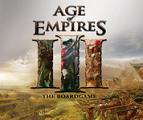
|
“Good poets borrow, great poets steal.” The landscape of the board gaming hobby hasn’t looked the same since an unknown game by an unknown designer from an unknown publisher burst onto the scene in the autumn of 2005. More significant than any of those unknowns has turned out to be the unknown mechanic that this mysterious game employed. The concept of worker placement may seem like second nature to those who have joined the board gaming hobby sometime during the past three years (as natural as auctions, negotiation, resource management, action points, or area majority), but it’s actually an innovation of the 21st century… perhaps the innovation of the decade in the hobby. Unlike most other mechanics in board gaming, worker placement is much younger and in its infancy, and thus still being explored and put to use in a various ways. More importantly, it’s being put to use by various designers, all of whom have begun to stake their claim to the worker placement universe, each adding their own twist to the concept (for better or worse). As T.S. Eliot may or may not have said, “good poets borrow, great poets steal.” And great designers from far and wide have thankfully “stolen” the worker placement mechanic, unabashedly adding William Attia’s baby to their own games. Gamers everywhere can be thankful for this free flow of ideas and mechanics, as it has given us a wealth of worker placement games to choose from. Then again, it sometimes seems as if all we have to choose from over the past few years has been each designer’s different take on worker placement. But that’s to be expected with such an innovation and its use is certain to drop-off over time as the novelty wears off. In case you haven’t gathered yet, the formerly unknown game is Caylus, the designer is William Attia, and publisher is Ystari. Of course none of them are unknown now. -- Click here to continue reading... |

|
I made my Boardgame News debut today with the republication of an edited version of my Survival Games article. You can view a list of my collected works as well as my brief biography on Boardgame News. All of my articles published on Boardgame News will be edited by the site's Editor W. Eric Martin. I will continue to also post all of my articles on this website in their original unedited form. I'm happy to be able to reach a wider readership through Boardgame News and I look forward to working with the site to bring you all of my random thoughts and reflections on the board gaming hobby. -- Click here to continue reading... |
Teaching a board game is partly an art and partly a science. It cannot be precisely explained or routinized, but it can be analyzed and discussed to some extent. While your method of teaching always needs to remain adaptable to the circumstances, the game, and the pupils, there is a basic framework that can be (and should be, in my humble opinion) applied across the board. I don't consider myself good at very many things, but teaching board games is something I seem to have a knack for. It comes with a lot of practice and even more patience. What follows is a list of ten steps that I recommend trying next time you set out to teach a board game. These may not work for every teacher or every game group, but I've tried them out with all sorts of games and all sorts of people, and they work for me. In developing this skill, you should keep in mind that it's one of those things that will go unnoticed if done well, but will quickly call attention to itself if done poorly. A well taught game is a smooth experience that integrates the new players into the game as seamlessly and painlessly as possible without them giving a second thought to the fact that they're having to learn and memorize a plethora of new rules. Here are the steps that I consider essential to teaching board games well, and some words of warning about potential pitfalls that I've seen others fall into on occasion. -- Click here to continue reading...
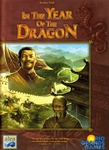
|
From trains, to farming, to a cathedral in Paris, it doesn’t matter what the setting is when I have the opportunity to fight the game system itself, in addition to my fellow players. While the game is not a traditional opponent, there are a handful of games where you struggle against the game just as much, if not more, than you struggle against your more traditional human opponents. These are games that certainly don’t appeal to everyone because they have a tendency to feel negative and oppressive, which is understandable given the pervasive motifs of famine, bankruptcy, and plague. Nonetheless, this is a loosely defined genre of games that I find myself drawn to more and more. It’s difficult to pinpoint exactly what is so enjoyable about this type of game, but I feel that it has something to do with the fact that you feel a sense of accomplishment once you’ve finished even if you lose to your fellow players because you’ve hopefully beaten the game system in a way just by managing to survive. Before I go any further, perhaps it would be best to give some examples of games from this genre to help you better understand since it’s harder to grasp in the abstract. The six games that immediately come to mind when I think of games in which a significant part of the game involves contending against the game system itself include: Age of Steam, Antiquity, In the Year of the Dragon, La Citta, Agricola, and Notre Dame (with the first three being the best examples). All of these games confront you with famine, bankruptcy, and plague, which are not traditionally what you’d think of as good themes for a fun board game. -- Click here to continue reading... |
Greg Williams recently posed the question over on the BoardGameGeek forums: “Why do you log your plays?”, referring to the practice of tracking every board game that one plays using a tool available on BGG for doing so. People had all sorts of answers for why they do or don’t bother keeping track of every time they play a board game, but the question made me wonder why I bother to go through this process of keeping accurate records of my time spent enjoying this hobby. I realized that many of the advantages of logging your plays stem not from BGG itself, but rather from John Farrell’s “Extended Stats website.” This is not the first time I’ve written something inspired by this incredible website, as you may recall my article on the Cult of the New was also based on a new graph feature available on John’s statistics website that had particularly impressed me at the time. I should mention that to log your own games played, visit BoardGameGeek, search for the game you’ve played in the search bar, scroll toward the bottom of the individual game’s page, and in the “I Played This Game On” box you can set the date and number of times that you played that game, and then click “Submit.” Upon reading Greg’s question, I was prompted to revisit John’s website and rediscover all the wonderful reasons to diligently log your games played. You can see here the overwhelming wealth of information that is available for my own gaming history, from which I will now pick out some of the more interesting facts to discuss. The Extended Stats website is great for little tidbits of fun information, such as the fact that on average I have played each of the games I own 9.38 times, but it’s even better for looking at trends over long periods of time, such as months and years of games played. To celebrate the fact that I’ve been keeping track of my games played for exactly three years now (since June 28, 2005), I’m going to take a look now at three different features of that site that provide a window into the past three years of my gaming history. First, I’ll take a look at a table of my games played by month, including the game I’ve played the most each month and my favorite new game each month. Second, I am going to discuss a list of game designers, ordered by the number of times that I’ve played each of those designers’ games. Third, I’ll finish by analyzing the games that have dropped off the radar, meaning games that were played multiple times in one year, but zero times in the following year, to see why those games have dropped of the radar and whether I’ve forgotten some gems in my rush to always try to the next new release. -- Click here to continue reading...
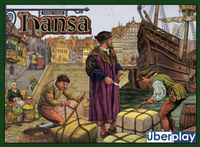
|
Hansa is a game of creating and maintaining loops. There are four possible loops that you need to be aware of and consider throughout the course of the game. They are Reval-Riga-Danzig, Lubeck-Aalborg-Copenhagen, Tonsberg-Stockholm-Kalmar-Copenhagen, and Kalmar-Copenhagen-Danzig. I will consider the strengths and weaknesses of each loop in turn. Regardless of which loop you choose to pursue, you need to be mindful of all of these loops throughout the game, making sure that you don’t allow your opponent to easily take control of one of them and exploit its strengths to your detriment. -- Click here to continue reading... |

|
John Pizer, Joseph Lane, Madame, Spring-Heeled Man, and Abberline. These are the new suspects in the Whitechapel district of London. The night still covers the gloomy alleys with darkness and only a few corners are still illuminated by the gaslights, and the mood is set for a tense game of Mr. Jack yet again. Thirteen investigators have now gathered to catch the cunning villain, who is impersonating one of them. The five new characters introduced by the Mr. Jack Extension breathe new life into the game, reinvigorating the game play and making for a fresh experience. Bruno Cathala and Ludovic Maublanc, the original designers of Mr. Jack, along with Steve McKeogh and Arnaud Fillon, winners of the contest to submit ideas for new characters and abilities, have added a nice mix of ideas to the game that both significantly expand the universe of possibilities but still stay true to the spirit of the game and feel familiar. Balancing and achieving those opposing goals is the key to making a great expansion, or should I say extension. The Mr. Jack Extension is one of a select few expansions that successfully merges innovative concepts into a base game while still maintaining the balance and flow of the original. -- Click here to continue reading... |
Antiquity is brutal. That is simply the most obvious adjective to describe it. Antiquity is unrelenting, vicious, and merciless. It is a game of pollution and graves. It is a game of treading water in a small pool teeming with piranhas. It is a game of survival. And it’s a pure joy to play. The introduction to the rules puts it best:
"These fields no longer yield grain the way they used to," complains the farmer. "And people these days don't like to eat plain bread any more. Why don’t we start farming olives, like our neighbors?" The cart-driver nods: "We could, but there is no more land. Ever since those city folks started worshipping San Giorgio I have to travel further and further to new building sites. I'm on my way now to that new inn. I'll change horses there. Then I’ll take this load," he gestures towards the pile of wood in the cart with his head, "to the sea beyond. Gonna start some fisheries there. The seas in the South have all been polluted, and the city folks need their fish. You know how it is." As the cart starts moving again, the farmer nods his head in reply, then takes his sickle to harvest the last bushels of grain, growing between the stumps of what used to be a lush forest." -- Click here to continue reading...
It’s counterintuitive but true that making a board game freely available to play online may in fact lead to increased sales. I had been pondering this thought for some time now, but was recently impelled to compile all of the instances in which this was the case for myself. I have only just now begun to realize how many games I have purchased as a direct result of being exposed to playing them online. It is a sizeable percentage of my collection indeed. This vague notion was recently crystallized when I read a discussion between Eric Endres and Bruno Cathala available at this link. Bruno is one of the designers of Mr. Jack in 2006 and the Mr. Jack Extension in 2007, along with a host of other well-known games (e.g., Shadows over Camelot, Cleopatra and the Society of Architects, Mission: Red Planet, Queen’s Necklace). Eric points out that "it should be noted that providing a free online version of a game doesn't necessarily hurt sales, and the opposite may even be true. Having played the online version of Mr. Jack, it is now on my 'must have' list to buy soon. The same thing happened when I discovered Tikal at spielbyweb. I bought that the first chance I had . . . I know it sometimes may seem counterintuitive to selling something by providing it for free. And sometimes it is, but in this case I think it definitely features the game in a way that will help generate buzz and sales for the board game version." I strongly agree, and would go even further in emphasizing how much I think making a game available to play for free online can help improve sales. -- Click here to continue reading...
Matthews' Masterpieces ComparedApril 22, 2008 |
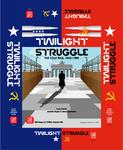
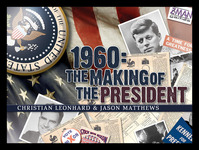
|
“Now the trumpet summons us again, not as a call to bear arms, though arms we need; not as a call to battle, though embattled we are – but a call to bear the burden of a long twilight struggle” – John F. Kennedy
Jason Matthews’ first published game was Twilight Struggle in 2005, and based on its success, he went on to publish the strikingly similar 1960: The Making of the President in 2007. Having played the former 9 times and the latter 5 times, I’m now going to endeavor to distinguish and critique these two games. My thesis is essentially that 1960 may be the superior game in terms of its mechanics, but that Twilight Struggle is far more engaging, tense, and enjoyable to play. Basically, 1960 introduces two key mechanics into the card-driven gameplay of this system that are definite improvements, but at the same time 1960 removes the mid-game scoring that makes Twilight Struggle an edge-of-your-seat affair. -- Click here to continue reading...
 Gaming Trends
Gaming TrendsClick here to read the full article...
 Nickels and Dimes and Quarters, Oh My!
Nickels and Dimes and Quarters, Oh My!January can only mean one thing, another Five & Dime List of course. Every list has to have a twist to make it unique, and since I didn’t do one last year, this one will be a comparative list that highlights how many times I played each game not only in 2007 but also in 2006. This means I’ll be able to see whether a game is on the rise or interest is declining, and maybe realize that a game I used to enjoy plenty in 2006 didn’t see enough table time in 2007.
Before we get started with the list, let’s begin with a few stats. Since I started tracking games played in June 2005, I have 1,834 plays (note that this number is slightly inflated by the fact that I log both the base game and expansion if I play a game with an expansion). Broken down by year, there were 357 plays in the latter half of 2005, there were 786 in 2006, and 658 plays in 2007. So it looks like 2007 saw a bit of downturn in gaming, with 128 fewer games played, which is not surprising given the fact that I was a full-time student in 2006, and graduated five months into 2007, so I had to study for the Bar exam and begin working full-time. This has decreased my game playing opportunities slightly, but thankfully not nearly as much as I had feared, so I’ve played plenty of great games in 2007 as you’ll see.
Click here to read the full article...
 Cult of the New?
Cult of the New?I have recently become fascinated by a relatively new feature on John Farrell's Extended Stats website for BoardGameGeek users. This feature doesn't even have a name yet, but is described on the site as a graph depicting the "proportion of games designed in a particular year played each quarter, i.e., how much do you play new releases?" It's a lot easier to understand this type of graph by actually looking at it than it is to describe it in words, so continue reading to see some examples of what I'm talking about.
For people who are members of BoardGameGeek and log their games played on that site, this graph appears to be a great way to see whether you are succumbing to the "Cult of the New." The "Cult of the New" is a concept that has been discussed a fair bit on BoardGameGeek and on various gaming podcasts, and is basically the notion that many board game enthusiasts are constantly searching for the next great thing in gaming, always buying new games, and therefore never replaying the ones they already have. Seeing as I just ordered 11 games immediately following Essen Spiel two months ago and have my eye on at least 4 more new Essen 2007 games, this is certainly something I've been pondering.
Click here to read the full article...
 Picking the Perfect Game
Picking the Perfect GameSometimes it feels like I spend as much time trying to decide which game to play as I do actually playing games. This is the inevitable downside of having a collection that has grown out of control over the past few years. With the great variety of over 150 games comes the great dilemma of picking one to play when the opportunity arises. I know I'm not alone in this, as I have seen a variety of discussions on this topic and attempts to alleviate the problem. W. Eric Martin wrote about this problem recently in his article "570 Games (And Nothin' to Play)," in which he discusses an intriguing book entitled "The Paradox of Choice: Why More Is Less." In an attempt to solve this problem, Tom Kiehl invented the game "I Don't Know, What Do You Want to Play?" This "game" involves a website that will create a personalized PDF for you including a card for each game in your collection. The "game" gives everyone a hand of cards representing games in your collection and has rules for playing those cards to determine what will actually get played. Another method for determining which game to play that I have seen proposed is to allow each person present to pick one game, give everyone a playing card from 1 to 4 (assuming four people are present so four games have been selected), and allow everyone to place one card on each game, then tally up the totals and the game with highest total gets played. These ideas are all well and good, but I thought I'd add to the growing trend of new methods for selecting which game to play by creating a handy chart.
Click here to read the full article...
 Games of the Years
Games of the YearsSpiel des Tom? Deutscher Spiele Tom? The best I could come up with was "Games of the Years" but I suppose it's the most descriptive and clear of the bunch. With the relatively recent announcement of the International Gamers Award (Through the Ages and Mr. Jack), Deutscher Spiele Preis (Pillars of the Earth), and Games Magazine Game of the Year (Pillars of the Earth), I decided it was high time for me to go through the arduous task of picking my favorite game from every year... stretching all the way back 131 years to good ol' 1876. You'll be surprised to know that somehow I wasn't able to come up with a Best in Show for every year, so I ended skipping a couple years. Thus, I present you with 18 Games of the Years. Please note that the the years are based on the years in BGG database, so for example, El Grande and Settlers both fall under 1995, despite the former winning the SDJ in 1996, and Age of Steam falls under 2002 despite winning the 2003 IGA.
You'll notice that these 18 games differ a fair bit from my Top 20. In fact, 8 of the Top 20 games were bumped because they were released in competitive years. The Top 20 games that failed to make the cut by a quirk of fate due to their release date include: Goa, Caylus, Carcassonne, Louis XIV, Reef Encounter, Settlers of Catan, Princes of Florence, and Wallenstein.
Unsurprisingly, the winning designer is Reiner Knizia with 3 Games of the Years (in contrast to his zero SDJ's of course), and Wolfgang Kramer comes in second place netting himself 2 Games of the Years (with my two favorite games - El Grande and Java). Interestingly, Rudiger Dorn failed to capture a single Game of the Year, but nonetheless had an impressive showing with 4 second-place finishes with Arkadia, Louis XIV, Goa, and Traders of Genoa. An impressive crop of games that got barely edged out in 4 different years.
Click here to read the full article...
 Fraternizing with the Enemy – A Discussion of the Dreaded Dice in Eurogames
Fraternizing with the Enemy – A Discussion of the Dreaded Dice in Eurogames

|
Disdain for dice and games that use them is clearly a common feeling among eurogamers. It’s not surprising, given the fact that most of us have embraced eurogames as the luck-minimizing and strategy-maximizing alternative to traditional American games, such as Monopoly and Risk. However, after playing Martin Wallace’s Byzantium for the first time the other day, it struck me how heavily some of the most treasured eurogames rely on the use of dice. Of course, while Byzantium entails a significant amount of dice-rolling, it is not one of these “most treasured” eurogames that I speak of, given the fact that it falls outside the Top 300 on BoardGameGeek (although I found it to be quite enjoyable and perhaps underrated, although more plays will be necessary to determine that for sure). However, the groans heard round the table when the dice didn’t go someone’s way (or even more extreme, failed to roll a single hit on five dice for one person, while rolling four hits on four dice for their opponent) led me down the garden path of pondering the role of dice in eurogames. |
Click here to read the full article...
 Maps Galore
Maps GaloreThe creativeness and ingenuity of gamers continually amazes me. This is especially true when it comes to the countless variants that are have been created for the most popular games and even many less well-known games. Unlike rules variants, which I’m sure require a good deal of time investment in their own right, it is the alternate maps for various games that I find particularly impressive, given the enormous amount of time that must go into conceiving and playtesting such creations. With the tons of new Age of Steam maps that come out at Essen each year, speaking of which, check out Ted Alspach’s Board 2 Pieces from October 19, 2006, and this year being no exception, I began to ponder just how many Age of Steam maps have been created. This led me down the garden path to wondering just how many Ticket to Ride and Power Grid maps had been created as well because even though the number of maps for those two games combined pales in comparison to the number of Age of Steam maps, there are still an incredible number of maps for each of those games. I then set out to create a table for each of these three games, depicting a photo of the map, the name of the map, the designer, and a link to where you can find out more information about each map. How did I pick these three games? There’s no particular reason; they’re just the games that came to mind as having a large number of variant maps, but feel free to let me know if I’ve overlooked a game that should have been included in addition to Age of Steam, Ticket to Ride, and Power Grid. In fact, please let me know if there are any omissions or mistakes, which I’m sure there are given the size of this project. As of uploading this project on October 10, 2007, I have found and catalogued 103 maps: 62 Age of Steam maps, 27 Ticket to Ride maps, and 14 Power Grid maps. They have been sorted alphabetically in the following tables. Finally, while it doesn't have anything to do with this specific project of mine, I just don't feel right writing about creativeness in the creation of maps without at least mentioning Mark Mahaffey's Mapology Portfolio, which you owe it to yourself to check out so you can see his amazing map creations.
Click here to read the full article...
|
  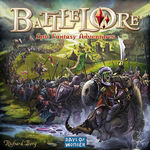
|
Whether I’m engaging in battle with British tanks, Carthaginian elephants, or dwarves and goblins, unfortunately I can’t count myself among the innumerable fans of Richard Borg’s Commands & Colors series of board games (i.e., Battle Cry, Memoir ’44, Commands & Colors: Ancients, BattleLore). However, before I launch into articulating my reasons for going against the grain when it comes to this highly touted quadrilogy of games, let me start by emphasizing that I don’t believe that any of these are bad games, but rather that they’re merely okay and I fail to see what’s so great about them. I should also admit that I’m certainly no expert on this series of games, and since three of them are ranked in the Top 50 on BoardGameGeek, I’m happy to admit that I may just be missing something. Then again, I’ve played the games in this series 4 times (Memoir once, Ancients twice, and BattleLore once), so I feel like I’ve given it a fair shake, and have nothing to show for it except a perplexed bewilderment at its incredible popularity.
Click here to read the full article...
 Across the Spectrum: From Haba to Splotter
Across the Spectrum: From Haba to Splotter
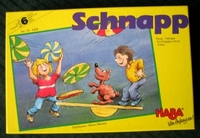
|
We all know about the great publishers like Rio Grande Games, Mayfair Games, Fantasy Flight Games, Z-Man Games, Hans im Gluck, Kosmos, Amigo, Ravensburger, Alea, Queen, Uberplay, etc. and their many wonderful light, medium-weight, and heavy games, ranging all the way from Fjords and Coloretto to Caylus and Puerto Rico. However, I’ve recently had the pleasure of playing games that actually fall outside that spectrum, despite its incredible breadth. Haba and Splotter Spellen are the two publishers I’m speaking of, and while the former publishes ultra-light games (ostensibly designed for children), the latter publishes ultra-heavy games with countless chits and hour upon hour of brain-burning gameplay. What’s incredible is that both publishers and their games are fabulous! I definitely believe that the Haba games that fall outside the traditional eurogame spectrum as being even lighter than the traditional fillers (i.e., For Sale, Coloretto, No Thanks, Hey! That’s My Fish!), and the Splotter games that fall outside the traditional eurogame spectrum as being even heavier than the traditional meaty games (i.e., Caylus, Puerto Rico, Tigris & Euphrates, Goa) complement each other quite well, and would actually do very well paired together for a game night. |
Click here to read the full article...
 Hey! There's a GeekList about that!
Hey! There's a GeekList about that!Have you ever been mid-conversation when you blurt out (or if you have more restraint than me, have the urge to blurt out), "Hey! There's a GeekList about that!"? Perhaps it's one of the many signs of spending too much time on BoardGameGeek (along with excelling at all of these contests), but I have to admit it happens to me on a regular basis... and I'm beginning to wonder who else this happens to or has happened to, and in particular, am looking for examples (and links to the GeekList if you can find it).
The most recent time was when I was teaching Notre Dame to few friends. After explaining that you started with 2 "money" and used 1 "money" to bribe a person each turn or could use your "money" to place cubes on the cathedral, I got the strangest question. They were like, "Money? But what's it actually called in the game?" I stopped to think for a second and realized I had no idea. So we stopped the explanation for a while to check the rulebook and discovered that the currency was in fact gold coins. Upon this somewhat anticlimactic discovery, I had the insuppressible urge to shout out, you guessed it, "Hey! There's a GeekList about that!"
Click here to read the full article...
 Super Fillers for 2
Super Fillers for 2su·per ('sü-p&r) adjective - exhibiting the characteristics of its type to an extreme or excessive degree
fill·er ('fi-l&r) noun - a piece used to cover or fill in a space between two parts of a structure; material used to fill extra space
Super Filler - Coined and defined by Mike Siggins in the Gamer's Notebook on October 25, 2006:
"The Super Filler is really a subtype of game that I used to call The Middleweight. It is more than a 20 or 30 minute starter, but it does not amount to a main course in weight or play length. The game is 'straight in,' has plenty of decisions, a fair amount of depth, but importantly it is very quick to play. Almost always under an hour, and leaving you feeling as if you have played for longer. In many ways it is an important species of German Game because it can avoid many of the traps – too light, too random, too boring – and appeals to most types of player. And those that don’t like it can see that it won’t last that long. A typical Super Filler is Mykerinos. I would put Yspahan, Taluva and Gheos in the same group."
I am on a quest to find an elusive subtype of this subtype of game, specifically Super Fillers that are best suited for 2 players. I want to find Super Fillers that are great for 2 players, not games that simply work for 2 players. This quest began after trying the "typical Super Filler" Mykerinos and finding that even though it is a good game, the two-player version did not appeal to me due to the "artificial third player" rule (also seen in Alhambra, Acquire, and Louis XIV). Consequently, I want to find other typical Super Fillers, but only those that shine as two-player games. As Mike explained, these should be games that take around 45 minutes to play, and certainly no more than 60 minutes.
Click here to read the full article...
 Patience isn't Always a Virtue
Patience isn't Always a VirtuePatience is normally a virtue, whether in gaming or not. You don't want to commit those meeples until you draw the right tile in Carcassonne. You certainly want to save your cards in the Commands & Colors series until they'll be most effective. You've got to time your Bonus cards just right in Princes of Florence to use them on the correct work. However, this is a list of games where patience is not always a virtue. These are games where you're given one, and only one, chance to use an ability that will give you the opportunity to decimate your opponents, but it's clear that if you waste it too early then you won't maximize this ability's potential. However, the lesser known side of this equation is that if you wait too long to use such an ability then you won't get to use it at all! This is my problem. I treasure such abilities even more than their great worth and end up never finding the "perfect" opportunity to use them, and consequently often end up not using them at all (which is certainly worse than using them too early). What on Earth am I talking about? Perhaps a few examples will make it all clear...
What powerful game abilities are you often stuck with not having used at the end of the game because you waited too long to find the perfect opportunity to use them and ended up not using them at all?
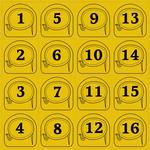
|
Ra - 13 Sun - Since this phenomenon first manifested itself in a game of Ra, it's known in my group as the "13 Sun" (since we play 3-player more often than not). So anytime another game has something analogous, it's called the "13 Sun." Am I the only one who overvalues the 13 Sun and often ends up not using it for an entire round when I have it (and consequently prefer to have the 11 or 12 if possible even though they're empirically worse) or are others prone to this excessive patience? |
Click here to read the full article...
 New Storage Solution
New Storage SolutionClick here to read the full article...
 Simplicity is Paramount
Simplicity is ParamountClick here to read the full article...
 GeekGold Exchange Rate
GeekGold Exchange RateNote: This article assumes the reader's familiarity with the fictitious GeekGold economy at the BoardGameGeek website.
Have you ever wondered how much all that GeekGold you've been collecting from GeekMod or been giving away generously through tips is really worth? If you figured it was a worthless virtual currency, then think again! Turns out your GeekGold is worth more than the Mexican Peso, Japanese Yen, Indian Rupee, and a whole host of other national currencies.
From this table summarizing all of the GeekGold exchanged for US currency via Auctions, you can see that since the Auction feature was introduced in July of 2005, 10,179 GeekGold has been exchanged for $1,444.38 for an average value of 7.05 GeekGold per Dollar, making each GeekGold worth a little over 14 cents. It's also impressive that in just over 4 months, over $846 has been spent purchasing GeekGold via the Auctions in 2007.
Click here to read the full article...
 Eye-opening GameSpot Review of Catan for Xbox
Eye-opening GameSpot Review of Catan for Xbox
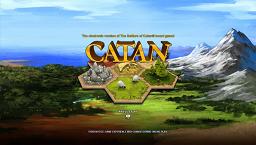
|
The recent review of Settlers of Catan for the Xbox 360 written by GameSpot was somewhat eye opening. It was actually a pretty kind review that didn't criticize the game as much as I'd feared (based on the Google Current lampooning of Board Games with Scott) and the UK Tabloid making fun of Jon Power), and the explanation of the rules in the review was pretty well done. However, I must say that the review reminded me how the "uninitiated" tend to view the idea of playing board games for fun. I can sometimes have a narrow view after spending a fair bit of time on this site, which makes me perceive fine differences between various strategy board games as wide gulfs, when they're all actually exceedingly indistinguishable from a laymen's perspective. It's odd to be reminded of that. My favorite line was when GameSpot called Settlers a "slow-pouring strategy game" and said "it's a fairly esoteric turn-based strategy game with a dry sensibility." Compared to many of my favorite strategy games, I'd never in a million years have thought of Settlers as "slow-pouring" and certainly not as "esoteric ... with a dry sensibility." Sounds more like some of my other favorites like Java, Caylus, or Age of Steam, heh, but I guess even the game we all consider the classic gateway game is slow-pouring, esoteric, and dry to others. |
Click here to read the full article...
 Revolution Number Nine
Revolution Number NineNine games in three days. Four heavy games (Liberté, Imperial, Die Macher, Antiquity) and five light games (StreetSoccer, Lord of the Rings - The Confrontation: Deluxe Edition, Bamboleo, eBay Electronic Talking Auction Game, Chairs). It all added up to a fun and brain-burning weekend.

|
Liberté – Radical Landslide Crushes Royalists - I had been wanting to try Liberté for over a year now, but it’s out-of-print and I didn’t know anyone who had a copy, so I’ve been patiently waiting to give this game a try for a long while. I was originally attracted to this game for three reasons. First, the photos of it on BoardGameGeek intrigued me. Second, it seemed like an innovative twist on the area control mechanic. Third, it’s by Martin Wallace of Age of Steam fame. After finally reading the rules for the game, I was very eager to give it a try. I especially liked the idea of two alternate ending conditions, which could trigger the end of the game prematurely, causing you to ignore the victory points that players had accumulated and instead look to an alternate winning condition. The basic idea is that each player can deploy Royalists, Moderates, and Radicals to control any of the 27 different regions of France. Over the course of four turns you aim to have the most control over the faction that ends up being the most powerful in the country by playing cards to lay down blocks of a particular faction. What makes the game really interesting are the two alternate ending conditions, which can occur if either the Royalists or the Radicals gain a certain amount of power, in which case victory points are ignored and the winner is determined by who controls the most of the faction that triggered the end of the game. This element make the game especially engaging because in addition to the traditional concept of area control, you have to always keep on eye on the different ways the game can end, and you have the possibility of manipulating the game (and your opponents) to achieve whichever of the three ending conditions suits you best. I should confess that I’m inclined to be a fan of just about any area control game you stick in front of me (such as El Grande, San Marco, and Louis XIV among many others), but that being said, Liberté is certainly another in this long line of fantastic area control games. |
Click here to read the full article...
|

|
I had the opportunity to play the board game Dune three times over the past month with different groups of people and was struck by how remarkably different all three games were. Each game of something like Tigris & Euphrates, El Grande, or Age of Steam is different (otherwise I wouldn’t keep playing them), but they tend to follow the same general flow and pattern as the previous game, with a clear beginning build-up, middle expansion, and end-game final push. Dune, on the other hand, did not conform to any of my board game expectations, even entering my third game after having played twice. This is a very good thing for a number of reasons. First and foremost, Dune holds a unique position in my collection, not only because it’s the only great game for six players that I’ve discovered, but also because it’s so different from anything else I own. Second, Dune isn’t just different from the other games I own, but also different from itself, with each game only vaguely resembling the previous games. This is great for the obvious reason of increasing the game’s replayability over the years, as long as I can continue to find five other people with four hours to spare. So what set each of my three games apart from each other so distinctly, let’s take a closer look at the individual games themselves since generalities about Dune give a very incomplete picture at best.
Click here to read the full article...
 The More the Merrier?
The More the Merrier?I should warn you now that this column is going to be even more subjective than most, which is saying something considering how unfounded my opinions generally are. Most people can probably agree that the number of players that a game should be played with doesn't always (maybe even often) line up with the number of players that the game says it can be played with on the box. It’s not hard to realize that the publishers want a game to appeal to as broad an audience as possible (even for such a niche market as German-style board games, or designer games as Alan Moon advocates), so it’s not a hard logical step to realize that games that claim to allow two to six players should generally sell better than games that only claim to allow three to four players. Why Settlers didn’t disabuse everyone of this notion is beyond me, but I digress. What everyone doesn’t agree on is what the optimal number of players for each game actually is, assuming it doesn’t match what the publisher claims. Sometimes its easy to find out what the designer thinks is the optimal number of players, as is the case with Age of Steam because Martin Wallace said in an interview by Tom Vasel that the game works best with four or five players, with only certain variant maps working best with three or six players, despite the fact that the base game says three to six players on the box. The game clearly “works” with three players, and also with six players, but this is about what number of players the game works best with. However, most of the time it’s harder to discern what the optimal number of players for a game really is because the designer doesn’t tell you and the publisher expands the range (which I recognize is a rational business decision).
Click here to read the full article...
 Let Me Choose My Color
Let Me Choose My ColorMetro, Entdecker, Australia... What do these three things have in common? If this were a game of Tribond, this would be the only question that I could actually get right. Have you figured it out yet? The answer’s not that I traded away all three games because I’ve only traded away two of them, yet. If you guessed that all three of these games limit a person’s color selection based on the number of players in the game then you are correct. As is probably clear from the title, this is a big pet peeve of mine. This has been the subject of repeated GeekLists on BoardGameGeek, cropping up every couple months, in which users attempt to list all of the games that share this more-annoying-than-it-ought-to-be trait. I’ve been meaning to write about my disdain, no... contempt, no... hatred, yes that’s it, of this phenomenon for a while now, but finally got the motivation after reading a recent thread on BoardGameGeek asking people what color they prefer to play. I realized that most gamers have a strong preference for what color they play; at least most gamers who are passionate enough to read and post on BoardGameGeek (ignoring the response bias that inevitably accompanies such an informal poll). As a minor aside, I was stunned at the number of people who always play yellow when it’s available for the exact same reason I do (i.e., we think it’s generally unpopular and therefore no one else will want it), how odd! However, I digress, back to the object of my loathing: games that limit a person’s color selection based on the number of players in the game.
Click here to read the full article...
 Board Game Internet Awards
Board Game Internet AwardsYou like me? You really like me! Yes, it's true, I had my very own Sally Field moment today when the Board Game Internet Awards were announced this morning on Boardgame News and BoardGameGeek. You can see the full list of winners on the Gone Gaming blog. Awards were given in a wide variety of categories, such as best publisher site, best game club site, best online gaming site, best blog, best podcast, best review, best session report, best strategy article, and best humurous article. I am very honored to have been recognized in three of these categories, especially given the amazing amount and quality of other people's work that was nominated.

|
Best Blog - I am very flattered to share the Best Blog award with the Gathering of Engineers blog. I hope that receiving this spurs me to write more because I have a long list of ideas for things to write about, and I seem to add five things to the list for every idea that actually comes to fruition. I'm never really sure if anyone reads this, so I mainly write for myself, but it's all the better if anyone else happens to enjoy it too. I must say that the blog field was extremely crowded with 13 nominations this year, and many were far more deserving than myself. In particular, I highly recommend that everyone check out Gamer's Notebook by Mike Siggins, Chris Farrell's Gaming Blog, and Mike Doyle's Art Play. Those three are really the cream of the crop in my opinion, and well worth checking frequently. You can find the full list of nominees in the Gone Gaming archives if you want to find even more excellent blogs. There's also an index of blogs available in my Links section below, plus a listing of blogs on the BoardGameGeek wiki. |
Click here to read the full article...
 Hilinski Brothers Tribute
Hilinski Brothers Tribute

|
After reading so much about Crokinole on BoardGameGeek, I finally decided that I had to have it. I read countless threads to research where to purchase a high quality board, and came up with a list of four possibilities. First, there's Wayne Kelly's (a.k.a. Mr. Crokinole) boards. Second, there's Willard's boards. Third, there's Miracle Venture's boards. Finally, there's Carl and Stan Hilinski's boards. While all four retailers had received high praise on BGG, I finally settled on a Hilinski board because the idea of owning a unique, one-of-a-kind board was just too great too pass up. I not only really liked the slideshow of past boards created by the Hilinski brothers, but I also liked the attitude of their website, about how they make boards for fun. I decided that I really wanted to patronize their business, and am glad that I did. I opened my new Hilinski board on Christmas morning, and despite my exceedingly high expectations, it has surpassed everything I hoped for. I've played it an astounding 42 times in the 20 days since I got it, and absolutely everyone I've introduced to the game has loved it. The Hilinski boards truly are works of art, rather than merely a game, and I'm currently figuring out where to hang my board on the wall. Here is a list of all of the photographs from the BGG image gallery that are identified as Hilinski boards in their captions, including a photo of the board and name of the board. |
Click here to read the full article...
 Crystal Ball: 2007 Predictions
Crystal Ball: 2007 PredictionsIt happened to the movies, it happened to video games, it's happening to board games... Sequel Mania. It makes sense financially to try to milk a product line for all its worth until its bone dry, since it's a bigger risk to try something new, but it sometimes leads to amusing results as you see how far they're willing to take a concept in an effort to avoid coming up with something new. What do you foresee in 2007? Let's all look into our crystal balls to predict the next big reinvention of the wheel. And we'll skip over the next Catan Adventure, Ticket to Ride map, and Carcassonne meeple; we can take those for granted since they're obvious enough even for amateur fortune tellers.
Click here to read the full article...
|

|
I generally agree with the masses, the BoardGameGeek masses that is. I heartily concur with the thousands of people who have voted Tigris & Euphrates, El Grande, Caylus, Ra, and Age of Steam into the Top 10 on BGG. My tastes and those of BGG at large very rarely diverge, but Power Grid stands out as the most prominent instance of this rare occurrence. Let me start out by saying that I have a profound respect for the design of Power Grid. I think that Friedemann Friese did an outstanding job of interweaving various clever mechanics into a well-balanced game. The supply-and-demand market system for resources is particularly nicely done, and an admirable feat in game design. However, I analogize the respect I have for Friese’s design to the respect I have for classic games such as Chess and Go, or the respect I have for classical music such as Beethoven or Mozart. To be clear, I don’t think that Power Grid nearly rises to the level of any of those four masterpieces, but the similarity lies in the fact that while I respect and appreciate the design of each, I simply do not enjoy playing (or listening to) them whatsoever. I don’t intend to write many negative game reviews; not because I have something against them (they can actually be quite useful to people one a limited budget), but rather just because I rarely find a game I don’t like. In this case though, I think it may be worthwhile for me to explain the shortcomings, as I see them, of Power Grid.
First things first, what will you get in the box and what is it going to cost you? Power Grid comes with a double-sided game board, 132 wooden houses (22 in six different colors), 84 wooden resource tokens (representing coal, oil, garbage, and uranium), paper money, 5 rules summary cards, and 43 power plant cards. Power Grid retails for $44.95, and is published in the United States by Rio Grande Games. The components of Power Grid are generally very good. The double-sided game board is a nice touch, and certainly something that I’d like to see more games (e.g., Ticket to Ride) include to increase replayability. The board has Germany on one side and the United States on the other, which provides excellent variety that many eurogames with maps lack. The paper money leaves something to be desired, but could easily be replaced by poker chips. Finally, one minor complaint with the components is that the wooden resource tokens representing oil are completely round (as opposed to the garbage tokens which have flat edges), and consequently tend to roll off the table quite frequently. Nonetheless, the components are generally well done, especially the double-sided game board.
Click here to read the full article...
|
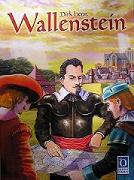
|
The year was 1618 and the Thirty Years’ War had just begun. The Peace of Westphalia was decades away, and there was much bloodshed and revolting to be done in the meantime. Five mercenary leaders came together to lay their claim to the regions of Brandenburg, Sachsen, Kurpfalz, Bayern, and Osterreich, but only one would emerge victorious after two vicious years and two lean winters.
Albrecht von Wallenstein lay his claim to the East, building strongholds in Regensburg, Ober-Osterreich, and Nieder-Osterreich, but still spreading out forces far to the North in Neumark and far to the West in Breisgau. Count Gottfried Heinrich von Pappenheim ordered his Pappenheimers to fortify the North, deploying forces to Holstein and Mecklenburg, but stretching his lines further South into Wolfenbuttel and Hessen-Kassel. Count Johann Tserclaes von Tilly formed a chain across the map, stretching all the way from Mahren in the East to Baden in the West, and North into Lausitz, Kursachsen, and Vogtland. Count Ernst von Mansfield concentrated his forces in the West, claiming almost all of Kurpfalz, but leaving a lone army in Schlesien in the far East. Finally, Gustavus Adolphus, the mighty King of Sweden, deployed his forces across the board, from Anhalt in the North, to Gft. Mark in the West, to Salzburg in the South.
The stage was set for the mightiest battle of the 17th century. All of the leaders divined that the year was ripe for a good harvest in Sachsen, but poor harvests in both Osterreich and Bayern, along with the possibility of the peasants becoming weary of war and trading in their swords for ploughshares.
Click here to read the full article...
 BGG.CON - Games I Would Have Played
BGG.CON - Games I Would Have Played400 lucky BGGeeks just got done with four amazing days of gaming at what sounds like the most wonderful convention ever, but that doesn't mean that the rest of us can't dream. So what would you have played if you'd gone? My list is a mile long...

|
After arriving late Wednesday night, my first game as soon as the doors opened on Thursday would have definitely been the Notre Dame prototype. I would tracked down Valerie Putman faster than a bloodhound and begged her to let me try out Alea #11 until she took pity on me and caved. Stefan Feld may have found few fans with Um Ru(h)m und Ehre, but it sounds like he's likely to find a boatload with this upcoming release. I know it's silly, but if it says Alea on the box, I just can't resist (I mean I already admitted earlier this year that I'd buy a turnip peeler if it was made by Alea, and I don't even like turnips). Larry Levy's right that Alea never really fell from grace to begin with, but even if this isn't technically a return to the glory days as Rick Thornquist suggests, I'm still psyched! |
Ah yes, I forgot to mention, that when I was registering with Aldie and his lovely wife, I didn't pick one of those plain ol' blue tickets, or whatever other colors there are, for some "regular" prize like a measly copy of Shogun or Die Macher, but instead I picked out a shiny golden ticket! They didn't even know it was in there, that's how surprised they were. Well, it turns out the golden ticket winner got copies of Roads & Boats, Full Métal Planète, Poisson d'Avril, and Hannibal: Rome vs. Carthage. Needless to say, I was pretty psyched about my golden ticket (even if it, and one of these games, don't exist).
Click here to read the full article...
|
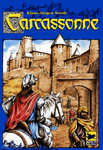 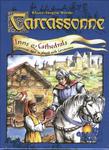 
|
Carcassonne is a tile-laying eurogame, which was designed by Klaus-Jurgen Wrede in 2001 and was awarded both the Spiel Des Jahres and the Deutscher SpielePreis that year. Carcassonne is often touted as one of the best “gateway” games (along with Settlers of Catan and Ticket to Ride) for introducing non-gamers to the hobby of strategy board games, and it’s true that the game can definitely be used as a “gateway” game. However, this review is meant to explain how Carcassonne can be played as a deep and heavy game along the lines of Tigris & Euphrates and Caylus. If played under the following conditions, Carcassonne can become a highly strategic and extremely replayable game with no more luck than a game of Tigris.
First things first, what do you get in the box? For a retail price of $24.95, you get the following components: 72 land tiles, 40 wooden followers (a.k.a. “meeples”), 1 scoring track, and 1 instruction booklet. The components are not spectacular, but they get the job done very well and don’t leave anything to be desired. Although the scoring track is not necessarily the best way to keep score because it can get bumped during play and is not as reliable as paper and pencil. I’m going to reference two expansions for Carcassonne below, so I will mention their price and components here as well. First, Carcassonne: Inns & Cathedrals (a.k.a. I&C) retails for $14.95. I&C comes with 18 land tiles, 6 scoring tiles, 8 gray followers, and 6 large followers (a.k.a. “gianteeples”). The new land tiles match the originals nicely, the scoring tiles and gray followers are essentially useless, but the gianteeples are crucial to the game as discussed below. Second, Carcassonne: Traders & Builders (a.k.a. T&B) retails for $14.95 as well. T&B comes with 24 land tiles, 20 trade goods, 6 builders, 6 pigs, 1 cloth bag. All of these components are up to par with the original and are necessary additions to the game. Both of these expansions are a bit pricey, but can be found at discount online retailers for $9.72, which is more reasonable, and are both integral to fully enjoying the game as I think it should be played.
Click here to read the full article...
 Reflections on Essen Releases
Reflections on Essen ReleasesAnother Essen Spiel has come and gone, meaning that it's time to flood the Internet with innumerable post-Essen reports on all the new game releases. This is only the second Essen since my obsession with eurogames began, but I've read so much coverage of the convention that I figured I might as well jot down my thoughts. I've read anything and everything about Essen on BoardGameGeek (see the 122 threads and geeklists on BoardGameGeek). I've read and re-read Rick Thornquist's coverage at BoardgameNews. I've enjoyed the report by Mike Siggins as usual, and scoured more blogs than you can shake a stick at, such as this one, and this one, and this one, and of course the masterful Kulkmann's G@mebox, not to mention monitoring the constantly fluctuating, and constantly dubious, Fairplay rankings.
Last year's Essen was singularly defined by Caylus. Essen was Caylus and Caylus was Essen. This year seems, at least from the other side of the pond, to have a very different tenor, as numerous games are fighting for the spotlight, and none yet stands head and shoulders above the rest. So it can be difficult to figure out what to be hopeful about, what to look forward to, and what to avoid or make sure to try before buying. So what am I looking forward to now and what am I planning to avoid:
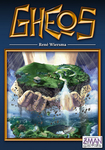
|
GHEOS is certainly my most anticipated game now and the game that I am most likely to buy without trying first. As evidenced by my personal Top 20 list, Tigris & Euphrates and Carcassonne are my two favorite games, so the innumerable comparisons between Gheos and those two games do nothing but bolster my desire to play the game. |
Click here to read the full article...
 Photomontage of my Collection throughout '06
Photomontage of my Collection throughout '06My fully updated collection list with individual comments on each game can always be found on my profile at BoardGameGeek, but here's a nice photo collage of my collection over the past year. One of the forum threads that I started a while back on BoardGameGeek dealt with game storage issues, specifically Crushing vs. Warping, so I'm always keen to hear more comments on how people store their collections. Here's how I've stored mine over the past year:
Click here to read the full article...
 The Predictive Power of Awards
The Predictive Power of Awards

|
With the recent announcement of the winners of both the International Gamers Awards (IGA) and Deutscher Spiele Preis (DSP) for 2006, I thought it would be interesting to see which award most closely matched my game ratings on BoardGameGeek, so that I could know which award would have the best predictive power for the purpose of finding more games that I'd enjoy. I know that awards are a hotly contested subject, especially since the announcement of the Golden Geek, with many people finding the proliferation of awards unnecessary and/or arbitrary. I don't want to get into the debate really, except to say that I personally think the awards are very useful, especially for new gamers just starting out to build their collections. While awards are not as useful for longtime gamers and active BGG users who follow the frequently changing rankings and read numerous reviews, I think one of the most useful methods for finding solid games when you're just starting off in this hobby is to look at which games have won awards and been nominated for many awards. Back when I started into this hobby and discovered the Spiel Des Jahres, I made it my goal to get each of the winners, but as my tastes have changed and evolved, I've abandoned that goal and instead have begun to pay more attention to other awards, such as the DSP and IGA. I decided to take a look at the five awards listed on FunAgain in order to see which award matches my ratings most closely. This is not meant to criticize any of the awards, I think the more awards the better, but rather just an experiment to see which award matches my current tastes best. If this is something you're interested in trying then feel free to post your results as comments below. Without further ado, here are the highly anticipated results, with the mean and median rating that I give to the games I own that have won the following five awards: |
Click here to read the full article...
 First is the Worst - Mitigating the Advantage of the Starting Player
First is the Worst - Mitigating the Advantage of the Starting PlayerAs the timeless childhood adage (and one of the best examples of sour grapes) tells us: First is the worst, Second is the best. However, this rarely holds true in the world of board games.
Eurogames provide us with an amazing array of methods for choosing the starting players, from youngest, to oldest, to the person who went swimming most recently, to the upcoming person who can refrain from laughing the longest (and no this is not going to be yet another list about ways to choose the starting player, for that go here). But whatever the method for choosing the starting player, no one ever likes having to go last (usually). Most games throw up their hands and say c'est la vie, but there are a few games out there that actually mitigate the effects of going later in turn order by giving those players a special bonus or penalizing the starting player, depends on whether your glass is half empty or half full. Here is a list dedicated to those games that attempt to balance the advantages of going first.
This list was inspired by a recent GeekList called "Games with a catch up mechanism" which specifically excluded games "that simply change the start components for the players based on the position that they begin play" (e.g., Reef Encounter).
Click here to read the full article...
 Richard Breese Visits Columbia Game Club
Richard Breese Visits Columbia Game Club

|
Game designer Richard Breese visited the Columbia Strategic Simulation Society on March 23, 2006. A summary of the members in attendance, the games played, and the winners is available here. Many games were enjoyed, such as Caylus, Ra, and Blokus, but the stars of the night were the two prototypes of upcoming games brought by Mr. Breese all the way from England. He brought prototypes of both Reef Encounters of the Second Kind and Fowl Play. I did not participate in the game of Fowl Play, although it looked very intresting and I'd love to pick up a copy if it is reprinted with a wider circulation than the 500 copies available at Essen. However, I did participate in Reef Encounters of the Second Kind, and thought that it was a fabulous expansion for an already outstanding game. The addition of cards adds more luck to the game, but restrains the blitz strategy by requiring a certain type of card before having your parrotfish consume your first coral. Moreover, the additional tile configurations are really interesting, especially the vicious crown of thorns. I really hope that Z-Man Games publishes this expansion with artwork that matches the second edition so I can pick up a copy. While the expansion with first edition artwork would work with the Z-Man version of the game, it would be much nicer to have a version of this expansion that matches the artwork of the base game. Thanks again to Richard Breese for coming to my club and bringing his prototypes with him. He was even kind enough to bring two copies of the Keythedral Expansion for me, as well as copies of O'Kudos for everyone in attendance! |
Click here to read the full article...
 Designer's Favorites
Designer's FavoritesWhile many game designers choose to refrain from rating games on BoardGameGeek, there are a number of designers who have rated numerous games. Whether or not you think it's appropriate for a game designer to publicly rate games, you may very well be interested in what some of your favorite designers enjoy playing themselves when they're not coming up with their greatest new creations. Here is a list of the prominent game designers that have rated games and their favorite games.
Click here to read the full article...
 Best Christmas Ever
Best Christmas EverThis is a companion list to the previous list I created in July, entitled "Best Birthday Ever." Back in July for my Birthday I acquired 19 new games, and pledged not to get any new games until Christmas (5 months!), and almost kept my promise to myself. I broke it on two occassions, the first was to buy San Marco and Elfenland from FunAgain during the $10 Sale, and the second was to add RA to a friend's order from Thought Hammer to push it over the $100 free shipping threshold. Other than that, I have been good, and I have made sure to play everything I got back in July at least once if not more, before going on this second splurge. As you can see below, I got a lot of games, both as gifts and for myself, and now I will make a new pledge. I will aim not to get any new games until May (another 5 months!), which is when my anniversary is. Alright, without further ado, these are the games that made this the best Christmas ever!
Click here to read the full article...
|
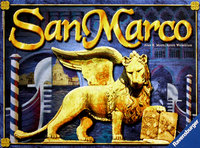
|
Decisions, decisions, decisions. Whether to go for a banishment and transfer, or to build a bridge and move the Doge? How many limit points to take? Which regions to go after; should it be Santa Croce and Dorsoduro or Castello and San Polo? What is everyone else going to try to do? These are just some of the many questions you will face during a game of San Marco. What difficult, agonizing questions the game poses, and what brain-burning fun it is.
First things first, what are you getting in the box and what does it cost? San Marco comes with 1 game board, 100 aristocrat blocks (25 in each of four different colors), 8 prestige markers, 12 plastic bridges, 62 action cards, 28 limit cards, 1 doge figure, 1 die, and 1 phase marker. San Marco retails for $35.00. The components are generally very good. The board is absolutely gorgeous, with very attractive colors, and is also functional, and not too distracting. While the aristocrat blocks are a bit too small, this seems to be a common problem with eurogames. The bridges would be nicer if they were made out of wood, but the plastic bridges serve their purpose. The cards are small, but workable, and the images on them are clear enough to convey their meaning without being too cryptic. Finally, you may recognize the doge from Princes of Florence. Overall, the components are good (especially the board), but not exceptional.
Click here to read the full article...
|
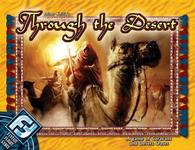
|
When you first open the box of Through the Desert, and see all those pastel camels and severed plastic palm trees rolling around there, you may wonder whether you’ve made a mistaken in picking up Herr Knizia’s own favorite design. Let me reassure you that you have not. In fact, far from it. In this game you will find many hours of engrossing gameplay hidden behind childish-looking pieces and straightforward rules.
First things first, what are you gonna’ get and what’s it gonna’ cost you? Through the Desert comes with 1 game board, 175 plastic camels, 30 plastic riders, 45 watering hole counters, 5 plastic oasis trees, and 40 point chips. The game retails for $29.95. That comes out to be about 17 cents a camel, which may seem a bit steep at first. The components of this Fantasy Flight game may leave something to be desired, particularly the game board, which never lays entirely flat, but what it lacks in presentation, it more than makes up for in gameplay. In the end, I think you’ll find the pastel pieces and clip-on riders somewhat endearing, and part of the game’s charm.
Click here to read the full article...
 Best Birthday Ever
Best Birthday EverI know what you're thinking: another stupid list about the games that someone recently acquired?! I do apologize, but I could not resist the opportunity to brag a little. Actually, no, I'm just glad my collection is growing and giving me the opportunity to try lots of new games. Moreover, this list hopefully gives me the opportunity to get your comments on these games and other games you recommend. Perhaps you can tell me what you think of the games I just got or about useful variants that you like to use when playing them. Or you could suggest games that I'm clearly missing and just need to get (don't bother suggesting Ra, El Grande, or Goa because those will all get ordered as soon as the reprints come out), but something like Attika or Clans or Through the Desert, which I'm considering, but am not yet sold out, could use some further praise or criticism. Anyway, enjoy, I know I will.
Click here to read the full article...